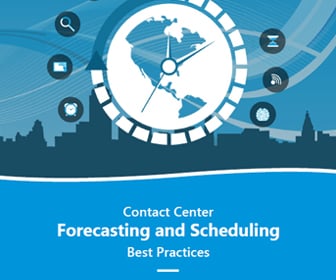Workforce Management Featured Article
October 30, 2008
Workforce Management Systems Only Deliver When Properly Fit to Contact Centers
The contact center industry is nothing if not dynamic, and in order to ensure that the contact center achieves optimal success and performance, it often must rely on third-party applications and solutions. One such solution is that of workforce management.
Workforce management systems are designed to serve to improve the tactical performance of contact center organizations. Algorithms within workforce management systems evaluate the collective value of contact center agent performance and help managers to organize their work and their workers.
Workforce management systems are designed to serve to improve the tactical performance of contact center organizations. Algorithms within workforce management systems evaluate the collective value of contact center agent performance and help managers to organize their work and their workers.
Workforce management systems, along with other contact center analytic tools, are in place to help analysts solve specific business problems. The biggest obstacle arises when those problems are not accurately defined.
While extensive research has shown that workforce management solutions deliver considerable benefits to the contact center, may organizations lack the necessary information in order to make an informed decision when it comes to selecting a workforce management solution.
Industry research has found that as many as 90 percent of contact centers have a workforce management solution in place, yet a much smaller percentage of centers have experienced measurable gains from these implementations. In some situations, this gap is a result of an overall lack of measurement; in others, it is a direct result of the wrong workforce management solution.
As part of the contact center analytical system, workforce management systems are in place to solve very tactical and mostly low level problems. One of the challenges within the contact center is that these low level problems are very important to the overall operation and success of the center, but are not always viewed as such by upper level executives. One key to effective workforce management systems is getting senior level buy-in and that must start with effective communication.
The performance of the contact center relies heavily on the performance of its people and unless those people are effectively managed, the contact center cannot deliver on all of its KPIs (Key Performance Indicators). At the same time, a workforce management solution that is selected without understanding needs will fail to deliver on expectations as those expectations are not clearly established.
When a company executes the purchase and implementation of the solution without first identifying specific needs within the center, much of the assumed workforce management solution benefits are never realized as the solution is not customized or implemented according to that specific center.
Industry research has found that as many as 90 percent of contact centers have a workforce management solution in place, yet a much smaller percentage of centers have experienced measurable gains from these implementations. In some situations, this gap is a result of an overall lack of measurement; in others, it is a direct result of the wrong workforce management solution.
As part of the contact center analytical system, workforce management systems are in place to solve very tactical and mostly low level problems. One of the challenges within the contact center is that these low level problems are very important to the overall operation and success of the center, but are not always viewed as such by upper level executives. One key to effective workforce management systems is getting senior level buy-in and that must start with effective communication.
The performance of the contact center relies heavily on the performance of its people and unless those people are effectively managed, the contact center cannot deliver on all of its KPIs (Key Performance Indicators). At the same time, a workforce management solution that is selected without understanding needs will fail to deliver on expectations as those expectations are not clearly established.
When a company executes the purchase and implementation of the solution without first identifying specific needs within the center, much of the assumed workforce management solution benefits are never realized as the solution is not customized or implemented according to that specific center.
To avoid this conflict, it is important that the contact center work with a vendor that fills the role of the consultant, helping the center to first identify need before ever making a recommendation. Monet Software is one vendor that can provide the guidance necessary to recommend the right workforce management solution and ensure that the system delivers as promised.
As a workforce management solutions provider, Monet Software offers integrated consulting services and training to help contact center companies achieve long-term success.
Monet Software helps businesses to leverage their workforce investments for efficient deployment of critical resources and effective management of people-processes – significantly impacting customer service levels and business profitability. Monet’s workforce management solutions help contact centers focus more on improving customer service and cutting center costs, instead of concentrating on labor and time-consuming management activities.
Susan J. Campbell is a contributing editor for TMCnet and has also written for eastbiz.com. To read more of Susan's articles, please visit her columnist page.
Edited by Michelle Robart







